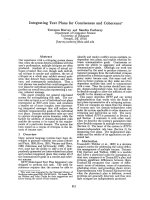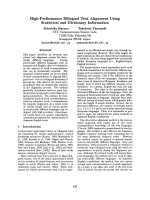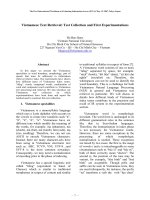Vietnamese text retrieval test collection and first experimentations
Bạn đang xem bản rút gọn của tài liệu. Xem và tải ngay bản đầy đủ của tài liệu tại đây (241.93 KB, 7 trang )
The First International Workshop on Evaluating Information Access (EVIA), May 15, 2007, Tokyo, Japan
Vietnamese Text Retrieval: Test Collection and First Experimentations
Ho Bao Quoc
Vietnam National University
Ho Chi Minh City School of Natural Sciences
227 Nguyen Van Cu – Q5 – Ho Chi Minh City – Vietnam
Abstract
In this paper we present the Vietnamese
specialities in word boundary, morphology, part of
speech that must be addressed in information
retrieval relative tasks. Our experiments have shown
how different types of Vietnamese index terms:
“tiӃng”, words, compound words, combination of
word and compound word contribute to Vietnamese
text processing and retrieval. We also introduce our
Vietnamese test collection on which
experimentations have been done and report the
method used to construct this test collection.
1. Vietnamese specialities
Vietnamese is a monosyllabic language
which uses a Latin alphabet with accents on
the vowels to create new tonalities such “ă”,
“â”, “ê”, “ô”, “ѭ”. Vietnamese have six
different tons which modify the meaning of
the words, for example: ma (phantom), má
(cheek), mà (but), mҧ (tomb), mã (code), mҥ
(rice seedling). Therefore, we can not use
ASCII to encode Vietnamese characters.
Instead, there are many character-sets have
been using in Vietnamese electronic text
such as: ABC, TCVN, VNI, UTF-8…and
UFT-8 is the most common nowadays.
Consequently, we may need a normalization
of encoding prior to the phase of indexing.
Vietnamese has a special linguistic unit
called “tiӃng” (equivalent to hanzi of
Chinese) which is similar to traditional
morphemes in respect of content and similar
to traditional syllables in respect of form [7].
A Vietnamese word consists of one or more
“tiӃng” separated by space, for example:
“sách” (book), “dӳ liӋu” (data), “xă hӝi chӫ
nghƭa” (socialist) etc. Therefore, the
whitespaces can not be used to identify the
word boundary. This is a challenge for both
Vietnamese Natural Language Processing
(NLP) in general and Vietnamese text
retrieval in particular. We will discus in
details how different kinds of Vietnamese
index terms contribute to the precision and
recall of IR system in the experimentation
section.
Vietnamese word is morphologic
invariant: The word form is unchanged to its
different grammatical roles in the sentence
like that in Euro-Indian languages.
Therefore, the lemmatization in index phase
is not necessary for Vietnamese words.
However, there are some exceptions in the
processing of which morphologic
normalization is needed. These exceptions
are raised by two cases: the first is, the usage
of vowels i and y is interchangeable in some
circumstances such as “bác sƭ” and “bác sӻ”,
both of them correctly mean “doctor”. The
second is, the position of the tons may be
variant, for example, “hòa bình” and “hoà
bình” are acceptable. Though prfix and
suffix can be seen in Vietnamese texts, they
are used infrequently, for instance, the prefix
“sӵ” transform a verb the verb “lӵa chӑn”
The First International Workshop on Evaluating Information Access (EVIA), May 15, 2007, Tokyo, Japan
(choose) to a noun “sӵ lӵa chӑn” (choice),
yet “lӵa chӑn” itself is also a noun with the
meaning of “choice”, on the other hand, the
suffix “hóa” transform a noun “hiӋn ÿҥi”
(modern) to a verb “hiӋn ÿҥi hóa”
(modernization)
Unlike in morphologic variant language, the
part of speech (grammatical category) of
Vietnamese word can’t be recognized from word
form. It dependent, however, on the context of
word:
“Thành công (success) cӫa dӵ án ÿã tҥo tiêng
vang lӟn”
“The success of the project makes a big echo”
“Anh ta ÿã thành công (succeed) trong nghiên
cӭu khoa hӑc”
“He have succeed in scientist research”
“Buәi biӇu diӉn ÿã thành công (successful) “
“The show was successful”
The word Thành công in the first sentence
is a noun, whereas in the second, it is a verb and
in the third one, it is an adjective.
With the mentioned specialities above, we
suppose that to get a high precision in
Vietnamese text retrieval systems, NLP
techniques should be applied to extract index
terms that well represent the content of the
documents. At least, Vietnamese Word
Segmentation should be incorporated to identity
Vietnamese words correctly. This hypothesis has
been tested and results have been shown under
experiments section.
2. Test collection
We have been constructing a Vietnamese
test collection for our experimentations to
identify the better index term for
Vietnamese text retrieval. We used the
pooling method to construct such collection.
As well known, a test collection for IR
system test consist three parts: document
collection, topic set and relevance
assessments for each topic. The choice of
search topics is important since better topics
yield better reliability of the test collection.
The search topics are chosen base on
characteristic of language, size (in number
of words) and the search domain. The
relevance assessment constructing is the
most tedious and time consuming phase. Of
cause, we can’t judge the relevance of all
documents in the collection. Therefore we
have been used the polling method [5] to
build the relevance assessment file. We
construct our test collection as following:
2.1 Document collection
Our text collection contains two parts: the
first part is set of Vietnamese well known
news papers (tuәi trҿ, thanh niên …) given
by “Centre of Information and Prohibition of
Ho Chi Minh City” (VN1). The original
encoding of this collection is in TCVN
character-set, we have transformed this part
to UTF-8 character-set. This collection
consist 11.398 documents of about 30Mb.
The documents are tagged in SGML-like
format.
The second part is the set of Vietnamese text
(VN2) extracted from Vietnamese - English
text collection. It contains 25.215 documents
of approximately 69MB. This bilingual
collection we had mined from the web site
VOA [8], it contained about 1000 document
pairs English – Vietnamese.
Collection Num of docs Size
VN1 11.398 30Mb
VN2 25.215 69Mb
2.2 Search topics
We have been constructing 14 search topics
based on the themes of the documents in our
document collection. These 14 topics would
The First International Workshop on Evaluating Information Access (EVIA), May 15, 2007, Tokyo, Japan
like to cover the different types of topics:
short topics, long topics, topics containing
simples words, topics containing compound
words…The set of topic is organized in
TREC topics format. Each topic contains a
narrative part giving how to judge whether a
document is relevance to the topic. This
information makes a guideline for the
human assessor.
<TOP>
<NUM> 10</NUM>
<TITLE>
Thѭѫng mҥi ViӋt Mӻ
</TITLE>
<DESCRIPTION> Các chính sách và
hoҥt ÿӝng liên quan ÿӃn thѭѫng mҥi giӳa
ViӋt nam và Mӻ
</DESCRIPTION>
<NARRATIVE>
Các chính sách mӟi trong quan hӋ
thѭѫng mҥi hai nѭӟc, các cuӝc tiӃp xúc
cӫa các tә chӭc thѭѫng mҥi cӫa hai bên,
các báo cáo vӅ kӃt quҧ cӫa sӵ hӧp tác
thѭѫng mҥi giӳa hai nѭӟc. Các bài báo
nói vӅ các vҩn ÿӅ trên ÿѭӧc cho là liên
quan.
</NARRATIVE>
</TOP>
Fig 1. An example of search topics:
<TOP>
<NUM> 10</NUM>
<TITLE>
Vietnam America Trading
</TITLE>
<DESCRIPTION>
The policies and activities relates to
trading of Vietnam and America
<NARRATIVE>
The new policies in trading of two
countries, the events are organized of
trading organizations of two contries, the
reports of trading cooperation Vietnam –
America, the documents relate the
subjects above are judged relevance.
</NARRATIVE>
</TOP>
Fig 2. Translation of topic in Fig 1
2.3 relevance assessment
We have used pooling method to
constructing the relevance assessment. We
use SMART, Lemur, and Terrier to make
the pool. For each system and for each
search topics, we use 50 top relevance
documents. These 50 documents are judged
by human assessors.
We are continuing to add more topics and
judges the relevance documents for new
topics. We are intention to having 25 topics
with relevance assessments in the next
month.
3. Experimentations
3.1 Indexing units for Vietnamese IR
As mentioned above, word is the basic unit
of indexing in traditional IR. Vietnamese
sentences is composed of continuous “tiӃng”
separated each others by white space, each
“tiӃng” being a string of Latin characters
with some special accents. A single “tiӃng”
may have no meaning by itself: most of
Vietnamese word is composed with two
“tiӃng”[4]. For example, in ngôn ngͷ the
latter is meaningful (linguistics) but the
former is not, and both “tiӃng” together have
also a meaning (language). Another specific
characteristic in Vietnamese document is
that a “tiӃng” considered separately may
have a different meaning than combining
The First International Workshop on Evaluating Information Access (EVIA), May 15, 2007, Tokyo, Japan
with two or three contiguous “tiӃng”
together. For example, trang trí means
“décor” (if used as a noun) or “to decorate”
(if used as a verb), but “trang” and “trí”
independently mean respectively “page”
(noun) / “to shift” (verb) and “mind” (noun).
So, to determine correct words for indexing
consists of detecting not simply meaningful
words but also words suitable meaning. In
the following, “term” will designate
meaningful word.
There are two methods of indexing [3@:
a) The first one relies on linguistic
knowledge and consists of dictionary-
based word segmentation. Sentence will
be segmented into terms which are
identified from dictionary entries. When
there are word segmentation
ambiguities, the longest-matching
strategy is used to select the best term.
For example:
“công ngh͏ thông tin”(“information
technology”) can be segmented in three
ways with 7 possible terms – {“công”,
“ngh͏”, “thông”, “tin”}, {“công ngh͏”,
“thông tin”}, and {“công ngh͏ thông
tin”}- all of these are meaningful but
the latter is chosen since it is longest
meaningful word.
Two main problems are raised from this
technique are:
x The loss in recall, this problem is
identical to the one in Chinese IR
>3@: when the longest matching is
used, only the longest term is
identified as an index. However, a
long term may contain shorter terms,
as indicated in the above example,
the term “công ngh͏ thông tin”
contains 6 others terms, and
documents indexed by “công ngh͏
thông tin” can also be referred under
two others terms such as “công
ngh͏” ( technology) and “thông tin”
(information) . Since these two last
terms are included in công ngh͏
thông tin – information technology,
they are not considered as
independent indexes for IR.
x The Unknown word problem,
especially proper nouns, new
political words, abbreviations, etc…
These words are less likely to appear
in the dictionary.
b) The second method is n-grams which is
a non based-linguistic technique.
Usually, uni-grams or bi-grams are often
chosen for its reasonable memory cost
and performance. And uni-grams or bi-
grams also fit well to Vietnamese
meaningful words. Longer words are
compounded from n-grams of length of
one or two. This method is very
powerful for resolving the above two
problems above.
x Regarding the loss in recall, in order
to detect shorter terms in a long term,
full segmentation of the long term
into bi-grams is done. Bi-grams
which have a meaning in Vietnamese
language can be determined by
scanning from left to right, and never
by selecting two “tiӃng” appearing in
the middle of the long term.
Therefore, for the term “công ngh͏
thông tin”(Information technology),
two selected bi-grams are “công
ngh͏”(technology) and “thông
tin”(information), yet never “ngh͏
thong” since it is nonsense. Thus in
Vietnamese text, we do not have the
cross-word segmentation
phenomenon as in Chinese
documents >3@.
The First International Workshop on Evaluating Information Access (EVIA), May 15, 2007, Tokyo, Japan
x Concerning proper noun, such as,
Hoàng Liên S˯n (name of a
mountain in North Vietnam),
segmentation based on bi-grams will
split this term into “Hoàng Liên” and
“Liên S˯n”. If both bi-grams occur
in the same document, there is a
higher probability that the document
concerns Hoàng Liên S˯n than those
with three uni-grams. This technique
can also be used to detect new
political terms or abbreviations.
Finally, the step of removing stop words in
Vietnamese documents needs specific
process, besides common technique as used
in European language for removing
prepositions, pronouns. We used a given
stop list to remove stop words as often seen,
and employ heuristic rule to detect
stopwords which are not in stop list. For
example, a possible rule used is: if a bigram
is in form XX (two word are the same) is it
is a stopword [4] : lâng lâng , chi͉u chi͉u .
3.2 Experiments
The SMART system [1] is used for the
experimentation.
The indexing results for a document are
vector of weights:
D
i
-> (d
i1
,d
i2
, ,d
im
)
where d
ik
(1dkdm) is weight of the term t
k
in
the document D
i
, and m is the size of the
vector space. The weight d
ik
of a term in a
document is calculated by ltc weight scheme
of SMART according to formula
¦
j
kjk
kik
ik
nNf
nNf
d
2)]/log(*)1.0)[log(
)/log(*]1.0)[log(
where f
ik
is the occurrence frequency of the
term tk in the document D
i
, N is the total
number of documents in the collection; n
k
is
the number of documents that contain the
term t
k
A query is indexed in a similar way, and a
vector is also obtained for a query
Q
j
-> (q
j1
,q
j2
, ,q
jm
)
Similarity between Di and Qj is calculated
as the inner product of their vectors, that is:
¦
k
jkikji qdQDSim )*(),(
Four kinds of test have been carefully
examined so that a comparison among these
results can be made in order to choose the
best way for indexing. In all four method
below, we removed stopwords :
1. using single word as indexes
2. using bigram
3. mixing single word and dictionary-
based segmentation
4. using dictionary-based segmentation
to find out units indexes
3.2.1 Single “ti͇ng” (uni-gram):
In the first examination, we indexed
a test collection using single “tiӃng” (uni-
gram) as index terms. The result of using
single word is imprecision but it may
provide a basic on which one can measure
improvements by other representation
methods. The average precision 11-pt for
this case is 0.3636
3.2.2 Using bigram
In the second, we used bigrams as
indexes. In this method, the average
precision is augmented to 0.3778, but lost of
precision for high recall
3.2.3 Mix uni-gram and dictionary-based
segmentation
In the third, we mixed 1-gram with
the application of dictionary-based
segmentation. In fact, we constructed
compound words in scanning from a
The First International Workshop on Evaluating Information Access (EVIA), May 15, 2007, Tokyo, Japan
lexicon. Moreover, we also kept 1-gram of
these segments. The average precision for
11-ptr is 0.4989.
3.2.4 Dictionary-based segmentation
In the last one, we used a small
machine readable Vietnamese dictionary
about 30 000 units. We have done a pre-
processing test collection by scanning from
left to right and looking up in the dictionary
in order to find a good segmentation. When
it had been found, we connected its words
by “under score” characters
1
. After this pre-
processing, we used the processed collection
to run SMART. The average precision for
11-pt is improved to 0.5625
The detail results of four methods of
representation are following:
1
“Under score” characters are used in order that
SMART will treat as a normal word.
Fig3.Recall–precisiongraphs
4. Concluding remarks and future
works
This paper is an overview of specific
problems of indexing for Vietnamese IR.
Accepted some problems which are proper
to Vietnamese documents (bi-grams
selection, stop words), most of methods used
are those already experimented in Chinese
IR. Evaluation the performance of three
methods mentioned above has proven to be
effective of using dictionary-based
segmentation method for Vietnamese IR.
We are trying application of statistic
methods to find out compound words that
have been not exit in our dictionary and
using linguistic knowledge to deal with unit
indexes more complex such as noun phrase
or verb phrase.
This research is carried out jointly with a
French team from the laboratory CLIPS of
IMAG and the University of Joseph Fourier
(Grenoble, France).
We are continuing to construct our
Vietnamese test collection by adding more
topics and modifying the relevance
assessments.
The First International Workshop on Evaluating Information Access (EVIA), May 15, 2007, Tokyo, Japan
References
[1] Gerard Salton, Michael J. McGill. Introduction to
modern Information Retrieval System. McGraw-Hill,
1980.
[2] C.J. van Rijsbergen. Information Retrieval.
Butterworths, London, United Kingdom, 1979.
[3] Jian-Yun Nie, Jiangfeng Gao, Jian Zhang, Ming Zhou.
On use of Words and n-grams for Chinese
Information Retrieval. Proceeding of the 5
th
International Workshop Information Retrieval with
asia languages. 1997.
[4] NguyӉn Kim Thҧn. Nghiên cͱu ngͷ pháp ti͇ng Vi͏t.
Nhà xuҩt bҧn Giáo Dөc. 1997.
[5] Gilbert G and Sparck Jones. Statistical bases of
relevance assement for the ‘Ideal’ information
retrieval test collection. BL R&D Report 5481,
Cambridge, England, 1979
[6] Doulag W. Oard. A survey of multilingual text
retrieval. UMIACS-TR-96-19. 1996
[7] Dinh Dien, Hoang Kiem. Vietnamese Word
Segmentation. NLPRS2001 - Proceedings of the
Sixth Natural Language Processing Pacific Rim
Symposium - November 27-30, 2001 –Tokyo, Japan
[8] Van B. Dang, Bao-Quoc Ho. Automatic Construction
of English-Vietnamese Parallel Corpus through Web
Mining. RIVF 2007 – Internaltional Conference on
Research, Innovation and Vision for the Future –
March 05-09, 2007 – Hanoi, Vietnam.









